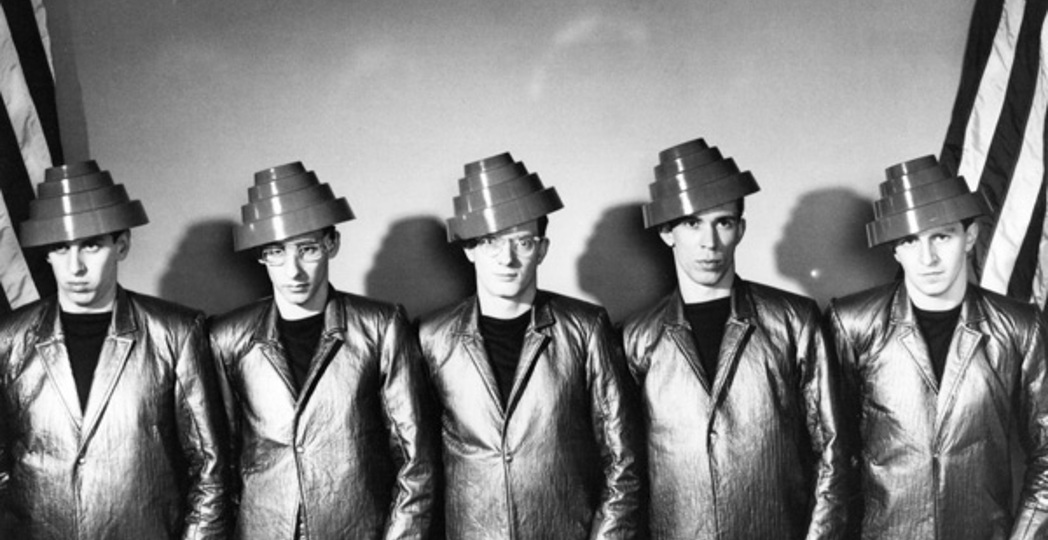The Case For Devo’s Induction Into The Rock And Roll Hall Of Fame
by Dillon Stewart | Apr. 1, 2021 | 4:00 PM

Courtesy Rock & Roll Hall Of Fame
Editor's Note: On May 12, the Rock & Roll Hall Of Fame announced its class of 2021, which did not include Devo. Click here to read the full list of inductees.
The Rock and Roll Hall of Fame’s biggest snub was born just 40 minutes down the road in Akron.
Devo, nominated this year, deserves “rock’s highest honor.” Sure, the avant-garde new wave band had only one major hit, “Whip It.” But its influence, inspiring acts as diverse as Neil Young and Rage Against The Machine, makes up for its lack of commercial success.
Devo is more art project than rock band. Drawing on dada and surrealism, Devo was Kent State University students Mark Mothersbaugh and Jerry Casale’s response to the May 4, 1970, shootings, in which two of their friends were killed. Exploring the idea of “de-evolution,” the band’s pop sensibilities masked a subversive social satire that pointed a finger at society.
“Their substance and artistic integrity was underappreciated in its time,” says David Giffels, former Akron Beacon Journal reporter and co-author of We Are Devo! Are We Not Men? We Are Devo! which is set for rerelease in the next year or so. “There was this very politically driven tension and anger behind what sounded like pop music.”
Long before MTV hit the airways, the band pioneered music video production with art-directed music films, launching Casale’s director career. Jim Mothersbaugh’s electronic drum and MIDI innovations became the backbeat of pop, while Mark Mothersbaugh would score the films of Wes Anderson and TV shows such as Rugrats.
“I think their role as innovators is what makes them so important today,” says Giffels.
Gimmick or one-hit wonder Devo is not. It’s time these local legends get into the Rock and Roll Hall of Fame. We talked to Giffels, who is currently revising his book on Devo with co-author Jade Dellinger, about the Akron band’s lasting legacy.
Cleveland Magazine: Why is Devo’s legacy so lasting?
David Giffels: I think there are three reasons their staying power has been stronger than other acts from the new wave era and genre, and they still continue to have this influence and this credibility, among modern artists.
First of all, their substance was under recognized in its time but is more recognized now. Just their artistic integrity. Mark Mothersbaugh and Jerry Casale were the two main thought leaders of Devo, and they were both serious artists, who took
up music as one aspect of their art, but Mark Mothersbaugh has made visual art really his whole adult life. Jerry Casale was a serious video artist. So there’s a lot of foundation to the music that I think lasts, even if some of their work
seems dated. There’s hints to their conceptualism that I think is long-lasting. I also think as the idea of the music video has evolved over the past generation that they play a role as innovators as the very earliest practitioners of the
music video as, not just as a performance to sell records, but as an art form unto itself. Third is the innovations in technology that they were behind, especially early on. Jim Mothersbaugh was the drummer before Alan Myers became the permanent
drummer and really the driving force for their best years. Jim was just an electronics whiz, and he built one of the first electronic drum kits, which became obviously an important part of music. Moving forward from there, in the early- to mid-1970s,
he also worked on the earliest versions of MIDI technology, which allow the interfaces that make modern electronic music viable. So he’s sort of an unseen, faceless part of their technological innovation, but he was definitely a big part
of their formation and also their embrace of technology.
CM: How do you think coming from Akron influenced their sound?
DG: They’ve often talked about the fact that being from Akron led them to having all this industrial iconography to their look and to their, even to
their sound. That’s because they were in an industrial town. If they had come up in Silicon Valley, they might have different elements of aesthetic and culture and maybe adapted them through the same intellect and imagination but with different
pieces on the surface.
CM: What do people misunderstand about Devo?
DG: Devo was an art concept for years, starting in 1972, before they were really a band. They only became a viable rock band when Alan Myers joined in 1976
as the drummer. For me, the best musical version of Devo is as a really powerfully dynamic rock band.
CM: Are Devo a one-hit wonder?
DG: By the literal definition, they’re a one-hit wonder because they didn’t have any other true hits. “Whip It” was their only commercial success,
and it peaked at No. 14 on the Billboard charts in 1980. And when they got that one hit was when they had, what could be seen as, the goofiest look of their career, which was the flowerpot hats or energy domes. So if those are the only two things
that most mainstream rock fans know, it’s easy to dismiss them. It seems very superficial. So I think what people should know about Devo is the depth of their like sort of artistic backstory, and the fact that they created this whole sort
of deeply thought and conceived theory of “de-evolution” long before they really manifested as a rock band.
CM: Why do you think Devo didn’t get in the first time they were nominated?
DG: When I was a reporter at the Akron Beacon Journal, I covered the opening of the Rock and Roll Hall of Fame. One of the questions
at the time in Northeast Ohio was what Northeast Ohio artists belong in there, and I made the case from the very beginning that they belonged in there. If I could unlock the brains of the people who decide who gets in, I would be worth $10. Some
of it is industry politics. Devo had a horrible habit of shooting themselves in the foot when it came to the music industry. I think some of it is also this perception of them as a one-off or a joke band.
CM: What would it mean locally for Devo to be inducted?
DG: I think if Devo was inducted we would do the thing that we always do in Northeast Ohio and really any place that has to try a little bit harder
to get understood and recognized, which is make a big deal out of it. We cling to our native sons and daughters with hands tightly gripped around coattails in the hopes that it will elevate us all. So I imagine it being a really big deal, like
when Chrissie Hynde and the Pretenders were inducted.

Dillon Stewart
Dillon Stewart is the editor of Cleveland Magazine. He studied web and magazine writing at Ohio University's E.W. Scripps School of Journalism and got his start as a Cleveland Magazine intern. His mission is to bring the storytelling, voice, beauty and quality of legacy print magazines into the digital age. He's always hungry for a great story about life in Northeast Ohio and beyond.
Trending
-
1
-
2
-
3
-
4
-
5










